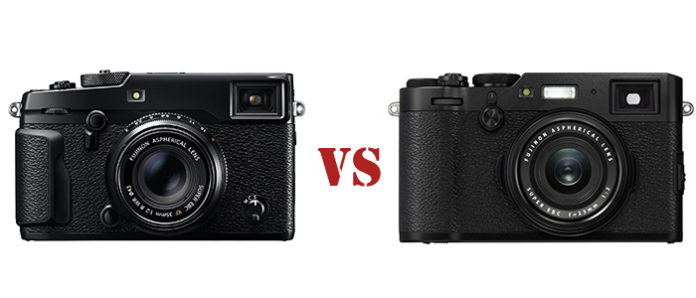


The X-T2 is ergonomically more sensible and comfortable. The position of the AF-L and Q button on the X-Pro 2 makes no sense, and the AE-L and metering button is too far over to the left. Even the positioning of the buttons make more sense on the X-T2, although I would still swap the position of the AF-L and AE-L buttons (this is possible in the custom button menu setting like the X-Pro 2).
#XPRO 1 VS X100T ISO#
The dedicated ISO and shutter speed dial are both lockable, the dials are tighter, the buttons are more ‘clicky’ and the shutter button has a nicer angle and feel. Both SD card slots on the X-T2 is UHS-II versus the X-Pro 2’s single UHS-II and second UHS-I type slots. There are other small but significant improvements on the X-T2 over the X-Pro 2. Using the standard shutter you get 11FPS, with 73 JPEGs or 30 lossless compression RAW files. Continuous shooting at 14FPS is also DSLR level speed, although this is limited to shooting with the electronic shutter only. The combination of the X-T2 and the XF35mm f/2 will get you very close to DSLR level AF speeds and accuracy.
#XPRO 1 VS X100T UPGRADE#
If you want to see huge AF improvements, you need to upgrade both your lenses and your bodies. However, throw on a first gen lens (XF35mm f/1.4) and AF is slow and hunts around. The XF35mm f/2 is the fastest and most accurate prime lens. The latest zooms and primes focus very quickly on both the X-T2 and X-Pro2. In practical use, I did find the X-T2 did lock onto focus slightly faster than the X-Pro 2, but the biggest bottleneck in AF with Fujifilm are the lenses. There is a dedicated AF-C Custom Settings section that allows 5 different ways the X-T2 will continuously track your subject (multi-purpose, ignore obstacles, accelerating/decelerating, sudden appearance, erratic movement) and a custom AF-C setting. Not only have they increased the amount of user selectable focus points (325 versus 273), but the focus area is noticeably wider on the X-T2. But things will change with this new camera.Īnother area that the X-T2 excels is autofocus. I would say that most Fujifilm photographers don’t really care about video, and it shows with how much effort Fujifilm has put into their video capabilities in the past. For many X-Pro2 shooters, video isn’t important. However, to truly succeed in video, Fujifilm needs video-centric lenses (either a wide zoom or wide primes with improved OIS), better AF tracking, video LOG format, and a dedicated headphone input. Yes, Fujifilm has finally decided to get serious about video production. The X-T2 also has a dedicated 1/8” or 3.5mm microphone input, as well as 4K video output via HDMI. The X-Pro2 is 4K capable, but Fujifilm decided to disable the feature for now due to overheating issues. Thank-you Fujifilm! The X-T2 also has 4K video output in 30, 25 and 24 FPS. The new X-T2 has a dedicated video mode via the DRIVE dial, now capable of using the shutter button to start and stop the recording. The first area the X-T2 will destroy the X-Pro2 is video. My copy of the X-T2 is pre-production and the firmware was not finalized, but it’s very clear that this body will outperform the X-Pro2 on many levels.
Although the final image will look exactly the same, how the photographer gets to the final image is what the major differences will be between these two cameras. However, this doesn’t mean the processor or firmware can’t be tweaked.

#XPRO 1 VS X100T SERIES#
Like the previous generation X series bodies, (X-T1, X-T10, X-E2s, X100T, etc.), the X-T2 and X-Pro2 share the latest generation sensor and processor. Let’s go over the things they both have in common. Which ‘type’ is better, the DSLR or the rangefinder? Which is better, the latest X-T2 or the X-Pro2? Apples to apples, or is it still apples to oranges? I say ‘style’ because neither category of body types are technically rangefinders or DSLRs, but they do conform to the ergonomic and functional purpose of these camera types. There are basically two body types: the rangefinder-style and the DSLR-style. Yes the X-Pro1 had the name, but the X-T1 was the top choice when it came to working pros (as well as the X100T). The X-T1 had the latest sensor, processor, firmware, superior EVF, AF and was weather resistant…it had everything! The only thing the X-Pro1 had over the X-T1 was the hybrid viewfinder, higher resolution LCD screen and the ‘pro’ designation. We can finally compare apples to apples, oranges to oranges… or can we? The X-Pro series has always been the official flagship body but the original X-Pro1 couldn’t keep up with the 2 years newer X-T1, the unofficial top-of-the-line body for Fujifilm. Same generation sensor, same generation processor and firmware. Fujifilm’s two flagship cameras have finally arrived, and almost at the same time.


 0 kommentar(er)
0 kommentar(er)
